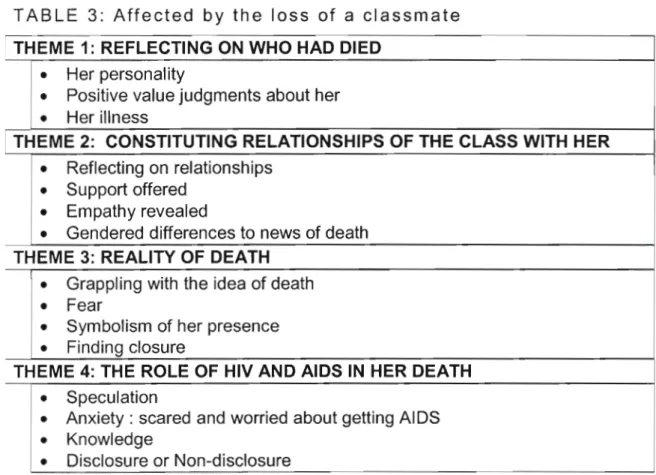The HIV and AIDS pandemic that has hit the world has affected not only those who have taken their lives, but also the loved ones left behind to cope with the trauma, stigma and discrimination of the disease. However, there appears to be little research available on the death of a classmate and the experiences of early adolescent survivors.
THEORETICAL LOCATION OF STUDY
Educational psychology deals with student development and the act of learning (Donald, Lazarus & Lolwana, 2002). Drawing on the literature on HIV and AIDS, as well as the literature on death, will facilitate the interpretation of adolescent responses.
STATEMENT OF THE PROBLEM
LOSS
Webster Comprehensive Dictionary (1992) refers to the words 'loss' and 'loss' as separation, failure to maintain, and the act or state of losing. A loss from death is considered a primary loss and subsequent situations that arise after the death, such as loss of income or loss of a future with the deceased, are seen as secondary losses.
AFFECTED
CLASSMATE
- THE SAMPLE
- DATA COLLECTION AND ANALYSIS
- ETHICAL CONSIDERATIONS
According to Hakim (2000) informed consent is an important part of research, therefore consent will be obtained not only from the participants but also from the parents. Participants will be informed of their right to withdraw from the research at any time.
DELIMITATION OF THE STUDY
Any research involving data collection from human subjects requires the researcher to maintain high ethical standards (Williams, Tutty. & Grinnell, 1995), but more so when the participants are.
COURSE OF THE STUDY
CONCLUSION
INTRODUCTION
One can only wonder how the death of family and friends will affect humanity and more specifically the younger generation, who are orphaned at younger ages (Malaney, 2000) and forced to assume the roles of adults responsible for families. , without being given the necessary bereavement counseling (Coombe & Kelly, 2000), as well as guidance, to assume the role of breadwinner and head of household (Malaney, 2000). I will reflect on the prevalence of HIV and AIDS to illustrate that the vastness of the epidemic and subsequent deaths will affect school-going adolescents.
THEORETICAL FRAMEWORK FOR THE STUDY
This refers to adolescence as the child develops through stages and physical and psychosocial factors influence the adolescent's development. Therefore, the use of the social constructionist perspective will help to understand students' reactions to the death of a classmate.
BRIEF BACKGROUND TO HIV AND AIDS
The understanding and responses of students who experienced the loss of a classmate will be influenced not only by cognitive and emotional factors, but also by their relationships, experience and understanding of death as a reality of life. Some of the predicted reasons for the rapid spread of the HIV virus have been: the movement and migration of people across large distances and countries, socio-economic instability, sexual activity, other STDs, intravenous drug use and ignorance of the disease (Eaton , Fisher & Aaro, 2003; Africa Bureau Policy Project, 2001; Green, 1994).
GLOBAL OVERVIEW OF HIV AND AIDS PREVALENCE IN THE WORLD
While HIV prevalence in 119 countries in the world has been indicated as less than 1%, these figures can be misleading due to early stages of the disease or concealment of real figures. This may explain why the statistics differ, but what is consistent is the severity of the pandemic and the increase of the disease in certain areas of the world (AVERT. ORG., 2006).
OVERVIEW OF HIV AND AIDS IN SUB-SAHARAN AFRICA
PROJECTED STATISTICS OF PREVALENCE IN THE NINE PROVINCES IN SOUTH AFRICA
The province in South Africa identified as having the highest prevalence of HIV and AIDS is KwaZulu-Natal (Stuart, 2006; Mwamwenda, 2004) with a prevalence rate of 37.5% and rising. HIV and AIDS prevalence rates are still rising in South Africa, indicating the important roles that awareness and prevention education programs must play in the coming years.

STIGMA AND DISCRIMINATION LINKED TO HIV AND AIDS
THE ADOLESCENT LEARNER
- INTRODUCTION
- STAGES IN ADOLESCENCE
- EARLY ADOLESCENCE
- MIDDLE ADOLESCENCE
- LATE ADOLESCENCE
- THE ADOLESCENT AND DEATH
- ADOLESCENTS' GRIEF AS AN EMOTIONAL RESPONSE TO DEATH
- DENIAL AND SHOCK
- TEARS AND PANIC
- GUILT
- DEPRESSION AND DISTRESS
- ANGER AND AGGRESSION
- ANXIETY
- ADOLESCENTS' BEHAVIOUR RESPONSES TO DEATH
Their understanding of the irreversibility of death as well as of their own mortality will again depend on the cognitive development of the adolescent (Webb, 1993). These stages of mourning are guidelines for possible reactions following the adolescent's experience of death and may vary depending on the situation of the death and the cultural practices.
COPING WITH DEATH AND BEREAVEMENT AT SCHOOLS
PROGRAMMES ELSEWHERE IN THE WORLD
- NORWAY
- UNITED KINGDOM
- THE USA
Cowie and Sharp (1998) report the introduction of similar procedures in the United Kingdom following the death of a peer at school. In the case study presented, symbolic gestures were performed, counseling facilities were made available and memorial services were held.
CURRENT STATUS IN SOUTH AFRICAN SCHOOLS
It appears that local authorities in these areas have contingency planning arrangements in place in the event of major incidents (Cowie & Sharp, 1998) and access to educational advice services to provide advice to pupils when required. In Seligman's (2004) report, the procedures following the death of a 14-year-old student are very similar to those of schools in Norway and Great Britain, where students were formally informed at a meeting and given paper to express their views could express. their feelings towards their deceased classmate and friend.
CONCLUSION
INTRODUCTION
PROBLEM STATEMENT
Schools, education and educators play an important role in the holistic development of adolescents, therefore it is important that they are aware of the emotional health of the learners. The secondary research question: What guidelines in the form of recommendations can be generated to facilitate support for learners in the school setting.
AIMS OF THE RESEARCH
This brings me to the primary question: What are early adolescent responses to the death of a classmate.
RESEARCH DESIGN
Cohen, Manion & Morrison (2001) agree that the main aim in the context of the interpretive paradigm is to gain an understanding of the personal experiences of the participants. The incidence of increased mortality is likely to have an impact on school-aged children and this research allows the researcher to gain a deeper understanding of their experiences and reactions, in the context of the classroom and school.
RESEARCH SITE
LEARNER COMPOSITION OF THE SCHOOL
SOCIO-ECONOMIC STATUS OF THE LEARNERS
A few of the learners at the school live in orphanages or are supported by welfare associations in the area. Since its inception, the building structure has been expanded over the years to accommodate more girls, but in 2005 the home disbanded and the girls were either moved to other orphanages in the area or reunited with their families if possible.
PURPOSIVE SAMPLING
I spent many Sundays as a young girl visiting my aunt and playing with the girls as they also went to the same school as me.
RESEARCH SAMPLE
DATA COLLECTION
I asked the participants for permission to audio record the interviews, as this would allow me to conduct an in-depth analysis (Greef, 2002). Field notes were taken immediately after the interviews were completed and were also used to facilitate interpretation and analysis.
DATA ANALYSIS
This method, also known as open coding, helped establish themes and categories that emerged from the interviews. After all the interviews had been analyzed, all similar units of meaning had to be grouped together.
TRUSTWORTHINESS
The audio-recorded interviews were then meticulously transcribed in order to ensure data accuracy. Confirmability highlights an important issue that data obtained from investigations is open to confirmation.
ETHICAL CONSIDERATIONS
All supporting documents, including letters of permission, audio tapes, documented interviews and interview coding, are available as needed for review and verification. Direct quotes from participants, used as a chain of evidence for findings, ensure consistency of data (De Vos, Strydom, Fouche & Delport, 2005).
LIMITATIONS OF THE STUDY
CONCLUSION
INTRODUCTION
FINDINGS
From the interviews, the direct quotes to be used will first be listed and then discussed in the themes below.
DISCUSSION
THEME 1: REFLECTING ON WHO HAD DIED
- HER PERSONALITY
- POSITIVE VALUE JUDGEMENTS ABOUT HER
- HER ILLNESS
The participants remarked that she was so considerate, so kind, so kind and yet she lived in a house. She lived in a house, she was so quiet that she didn't feel there was anything short in her life.
THEME 2: CONSTITUTING RELATIONSHIPS OF THE CLASS WITH HER
- AN IMPROVEMENT IN THE RELATIONSHIP
- SUPPORT OFFERED
- EMPATHY REVEALED
- GENDERED DIFFERENCES TO NEWS OF DEATH
This is further revealed in the responses of I asked her how she was and we used to stay in class with her as she told us about her life. The participants revealed that while their classmate was sick in the hospital, they used to pray for her in the morning.
THEME 3: REALITY OF DEATH
- GRAPPLING WITH THE IDEA OF DEATH
- FEAR
- SYMBOLISM OF HER PRESENCE
- FINDING CLOSURE
Following the news of their classmate's death, the participants had a moment of silence and prayer in class. The participants talked about their experience of the commemoration, as it was like saying goodbye.
THEME 4: THE ROLE OF HIV AND AIDS IN HER DEATH
- SPECULATION: PEOPLE PASSING RUMOURS THAT SHE HAD AIDS
- ANXIETY: SCARED AND WORRIED ABOUT GETTING AIDS
- KNOWLEDGE: COULDN'T GET AIDS BY JUST BEING HER FRIEND
- DISCLOSURE AND NON-DISCLOSURE
Participant responses such as having AIDS is a serious disease and maybe we could get AIDS indicate that early youth are aware of the seriousness of the disease as well as their fear of being infected. In the fourth category, disclosure and secrecy, the participants' responses will be discussed in two subcategories, namely the implication of disclosure and the implication of HIV and AIDS status.
INTRODUCTION
CONCLUSIONS
Regarding the reality of death, we can conclude that early adolescents are deeply affected by the death of a classmate, as they believe that death is easier to relate to the elderly. Considering the role of the HIV and AIDS virus in her death, we can conclude that early adolescents are by no means strangers to the HIV and AIDS pandemic that has affected the whole world.
RECOMMENDATIONS
Recommendations for the topic, the role of HIV and AIDS in her death, are intended for schools and educators. Educators must focus lessons and activities on supporting and accepting people living with HIV and AIDS, not only verbally but also in practice.
RECOMMENDATIONS FOR FURTHER STUDY
While knowledge of disease transmission, associated symptoms, and medical care are important, emotional care for people living with HIV and AIDS is also important. With South Africa ranked among the highest prevalence rates in the world, it is important to educate early adolescents as our future adults about the importance of accepting people living with HIV and AIDS.
FINAL CONCLUSION
What do we know about the perceptions that educators have of HIV/AIDS and their impact on the holistic development of adolescent learners. Interviews: An introduction to qualitative research interviewing. appropriate HIV/AIDS counseling in Arusha and Kilimanjaro regions of Tanzania: Implications for hospital counseling.
KWAZULU-NATAl
1, Informed consent form for students submitted in accordance with standard ethical guidelines (see attached. THE RELEVANT AUTHORITIES MUST BE CONTACTED TO OBTAIN THE NECESSARY APPROVAL, RESEARCH MUST INCLUDE THE USE OF SPACE AND/OR FACILITIES IN ORGANIZATIONS.
